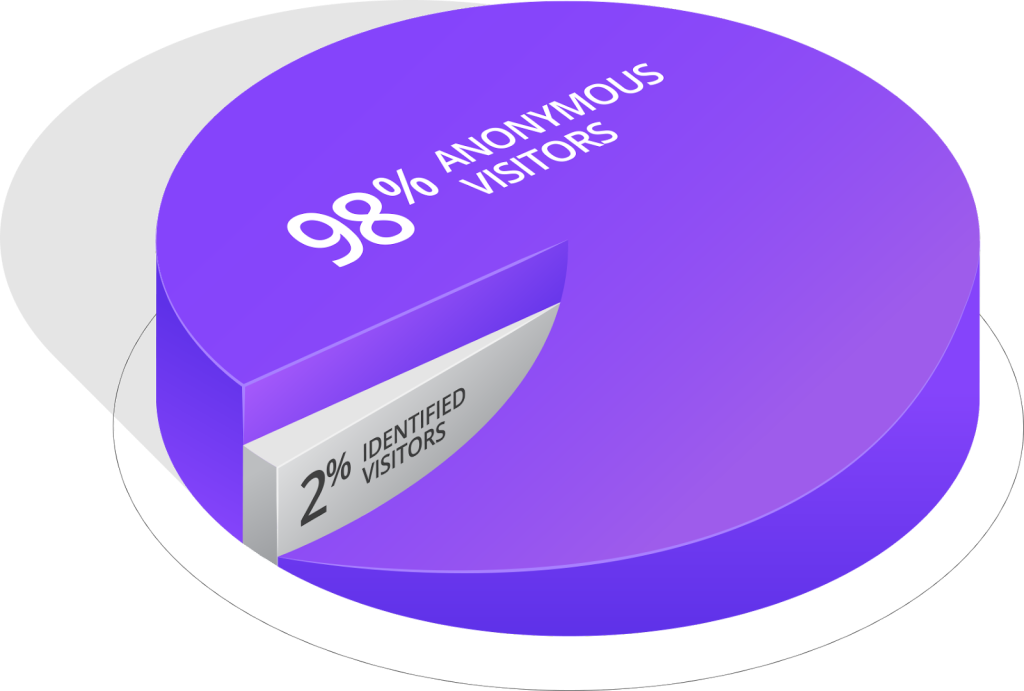In the realm of digital marketing, the spotlight often shines on acquiring new customers and engaging known audiences. But here’s the surprising reality: a staggering 98% of your website visitors remain in the shadows, hidden in anonymity. These are your potential leads, your goldmine of untapped opportunities.
The key to a great customer experience is data, allowing you to target the right audience, with the right message, at the right time. And the more data you have about your potential buyer, the more tailored the messaging can be to match the specific needs and interests of your audience.
However, the average website sees 97% to 98% of anonymous visitors, i.e. people who have never given you their email address. These could be first-time visitors to your site, or even returning visitors who are still not part of your CRM.

Unveiling the Power of First-Party Data:
First-party data goes beyond the traditional identifiers like email addresses, contact numbers, form submissions, and CRM data. It encompasses everyone who stumbles onto your website. In essence, anyone who interacts with your site becomes part of your first-party data. It’s the firsthand knowledge of your website visitors, and it holds immense value for refining your marketing, sales, and product development strategies.
Collecting First-Party Data:
First-party data is gathered through various channels, including website cookies, CRM platforms, social media profiles, and those elusive mid-funnel visitors—your anonymous website guests. These anonymous visitors, comprising a whopping 98% of your traffic, could have arrived via Google ads, Facebook ads, social media shares, newspaper ads, or organic searches. Among them, lie a high-intent audience eager to be nurtured and guided toward the bottom of the sales funnel.
Enhancing Facebook’s Custom Audience Match Rate:
Distinguishing between known and anonymous visitors, we gather essential information from both groups. Beyond the basic first name, email, and demographics, we collect Browser ID, Click ID, IP address, User-agent, Facebook ID, Google ID, and more from both known and unknown users. This treasure trove of first-party data significantly boosts Facebook’s custom audience match rate, often surpassing 80%.
Improving Event Match Quality:
Event match quality measures the effectiveness of transmitting customer information from your server to a Facebook account. High-quality event matching enhances campaign performance, attribution accuracy, and reduces the cost per action. With first-party audience data, we achieve match rates of 100%, ensuring optimal event match quality.
First-Party Data vs. Pixel Data: A Match Rate Experiment:
The impending demise of third-party cookie tracking emphasizes the importance of collecting first-party data. In a revealing experiment, we compared Facebook pixel data with first-party data from our website’s blog visitors. The results were striking: Facebook could match only 25% of users from a total audience of 16,000 with pixel data. However, with first-party data, Facebook’s matching capabilities soared beyond 90%. Google also demonstrated improved match rates for anonymous users when we experimented with sending them first-party data.
The Relevance of First-Party Data:
Unlike third-party data, which aggregates information from various web sources, first-party data is your own, collected directly by you. This makes it highly relevant for precisely targeting your audience.
Segmenting Your Mid-Funnel Audience:
While many e-commerce marketers focus on bottom-funnel segments like cart abandonments and checkouts, the mid-funnel audience requires a different approach. Consider segmenting your anonymous mid-funnel visitors based on user behavior:
– Users who have viewed a product more than three times
– Carts abandoned for over 30 days
– Users who viewed products but didn’t add them to the cart
– Users who have added more than 10 products to their wishlist
– First-time visitors, offering them ‘newbie discount codes’
Advanced segmentation based on user behavior allows you to predict the next potential action a user might take. For example, you can identify users likely to make a purchase within the next 10 days.
As privacy concerns continue to grow, it’s imperative to collect your customer behavior data—first-party data. Activate your audience throughout the marketing funnel to provide a personalized experience that resonates with users.
Anonymous website visitors are your high-intent potential purchasers, often overlooked and ignored. Collecting first-party data from these visitors is not only cost-effective but also ensures accuracy and reliability for your business. Embrace the power of first-party data and watch your conversions soar to new heights.
"NEXT LEVER OF GROWTH FOR BRANDS IS ACQUX"
In Conclusion:
Anonymous website visitors are your high-intent potential purchasers, often overlooked and ignored. Collecting first-party data from these visitors is not only cost-effective but also ensures accuracy and reliability for your business. Embrace the power of first-party data and watch your conversions soar to new heights.


